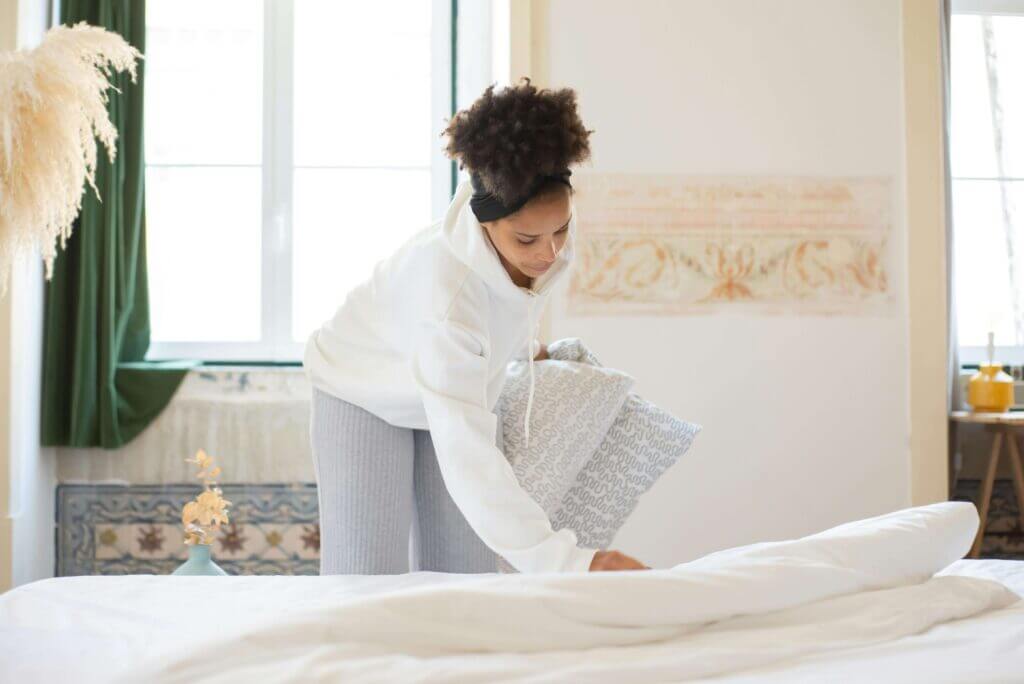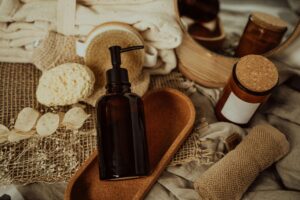Disclaimer: This post contains affiliate links, including links to Amazon. As an Amazon Associate, we earn from qualifying purchases at no additional cost to you. Thank you for supporting Low Tox & Thrive!
Not-so-fun fact: Indoor air quality is often 2-5 times worse than outdoor air due to chemicals released by common household products.
So it goes without question that creating a low tox home is one of the most impactful steps you can take toward a healthier lifestyle. By reducing exposure to harmful chemicals in everyday products, you’ll not only improve your well-being but also contribute to a cleaner environment.
In this guide, we’ll walk you through key steps to create a low tox home, including safer cleaning, cooking, and personal care choices, and offer suggestions for healthier alternatives.
Why create a low tox home?
Your home should be a sanctuary, but many everyday products—from air fresheners to furniture—contain harmful chemicals that contribute to poor air quality and long-term health risks.
According to the EPA, indoor air pollutants like volatile organic compounds (VOCs) are often 2 to 10 times higher indoors than outdoors. These toxins can aggravate respiratory conditions, disrupt hormones, and even contribute to chronic illnesses.
Benefits of creating a low tox home
- Improved indoor air quality: Lowering chemical exposure can dramatically improve the air quality in your home.
- Better health: Reducing toxins helps decrease respiratory issues, allergies, and potential hormone disruption.
- Eco-friendly lifestyle: Many low tox products are environmentally friendly, contributing to a cleaner planet.
Step 1: Evaluate your cleaning products
One of the easiest places to start when creating a low tox home is by rethinking your cleaning supplies. Many store-bought cleaners contain harsh chemicals like ammonia, bleach, and phthalates that can linger in your air and on surfaces.
Some environmental experts say the average household cleaner contains around 62 toxic chemicals that can harm your lungs and skin over time. Luckily, there’s alternatives.
Non-toxic cleaning alternatives
- DIY cleaners: Mix 1 cup of white vinegar, 1 cup of water, 10 drops of tea tree oil (antibacterial properties) and 10 drops of lemon essential oil (grease-cutting and refreshing scent) for an effective all-purpose cleaner.
- Eco-friendly brands: Opt for more natural cleaners from brands like Seventh Generation, PathoPure, and Aunt Fannie’s, which offer non-toxic and biodegradable products.
Step 2: Opt for non-toxic furniture and materials
Furniture and home decor can be a surprising source of toxins, especially when made with synthetic materials or treated with flame retardants and other chemicals. These can release VOCs into the air, contributing to poor indoor air quality.
What to look for in furniture
- Solid wood: Choose furniture made from untreated solid wood rather than particle board, which can emit formaldehyde.
- Second-hand furniture: Consider purchasing older, second-hand furniture which often contain fewer toxic chemicals and may be free from the flame retardants used in modern furniture. Just make sure to check for any signs of damage or mold, as these can also pose health risks.
- Natural fibers: Opt for natural fibers like cotton, wool, and linen for textiles instead of synthetics, which may contain chemicals like flame retardants or stain-resistant treatments.
- Low VOC paint: When painting your home, choose low or zero VOC paints to minimize harmful fumes during and after application.
Don’t forget about your shower curtain
Plastic shower curtains, especially PVC, can release harmful chemicals like dioxins and phthalates. Instead, choose a shower curtain that’s made of washable fabric and free of these toxins.
Step 3: Purify your air naturally
Since indoor air can be more polluted than outdoor air, improving air quality is crucial. While it’s impossible to eliminate all pollutants, improving air circulation and adding air-purifying elements can significantly reduce toxins in your living space.
Ways to improve air quality
- Houseplants: Certain houseplants like snake plants, spider plants, and peace lilies are known for their air-purifying properties, removing toxins such as formaldehyde and benzene from the air.
- Air purifiers: Invest in a high-quality air purifier with HEPA filters to capture dust, pet dander, and other airborne particles.
- Essential oil diffusers: Ditch synthetic air fresheners, plug-ins, and candles. These products often contain VOCs and phthalates, which can irritate your lungs. Instead, opt for essential oil diffusers, non-toxic candles made of beeswax, or make your own natural air freshener spray using water, vinegar, and essential oils.
- Ventilation: Regularly open windows and use exhaust fans to keep air circulating and to reduce indoor pollutants.
Step 4: Choose low tox personal care products
Many personal care items such as soaps, lotions, and cosmetics contain harmful chemicals that you absorb through your skin. Switching to natural alternatives is an easy way to reduce your toxic load at home.
Ingredients to avoid
- Parabens: Commonly used as preservatives in cosmetics but can disrupt hormones.
- Phthalates: Found in fragrances and can affect the endocrine system.
- Sulfates: Often used in soaps and shampoos, sulfates can irritate the skin and strip natural oils.
Safer personal care alternatives
Look for products that are labeled as organic, free from artificial fragrances, and made with natural ingredients like shea butter, coconut oil, and essential oils. For example, this Dr. Bronner’s Castile soap, these Sierra Bees lip balms, and this Arm & Hammer deodorant are all clean personal care products that align with a low tox lifestyle.
Check out our guide to natural skincare for more ideas.
Step 5: Choose low tox kitchenware
The materials you cook and store food in can also introduce toxins into your home. Non-stick cookware, plastic containers, and aluminum foil can all leach harmful chemicals into your food, especially when exposed to heat.
Safer kitchen alternatives
- Cast iron or stainless steel cookware: These are durable, non-toxic cookware and bakeware alternatives to non-stick pans, which are often Teflon-coated and can release chemicals like perfluorooctanoic acid (PFOA) when heated.
- Glass containers: Opt for glass storage containers instead of plastic to avoid BPA and other harmful chemicals.
- Beeswax wraps: Replace plastic wrap with reusable beeswax wraps for a sustainable, toxin-free food storage solution.
Step 6: Create a low tox laundry routine
Laundry products are another hidden source of toxins. Detergents, fabric softeners, and dryer sheets often contain synthetic fragrances, phosphates, and other chemicals that can linger on clothes and irritate the skin.
Safer laundry solutions
- Non-toxic detergents: Use eco-friendly detergents that are free from harsh chemicals, like these from Molly’s Suds or ECOS.
- Wool dryer balls: Replace chemical-laden dryer sheets with wool dryer balls, which naturally soften clothes and reduce drying time.
- DIY laundry detergent: You can make your own laundry detergent using simple ingredients like washing soda and Castile soap.
Feeling overwhelmed?
It’s completely normal to feel a bit overwhelmed by all this information. When you’re looking to create a low tox home, it can seem like a lot to take in. But remember, this information is not meant to intimidate you, but to empower you on your journey to a healthier living space.
It’s not realistic to change everything overnight, and you shouldn’t put that pressure on yourself. The path to a low tox lifestyle is a gradual process, and every small step you take gets you closer to your goal. That’s why we call it “low tox” rather than “non tox”—this approach is more true to life, practical, and sustainable.
To start, consider focusing on the most impactful areas of your home, like cleaning products and air quality. These are foundational elements that can greatly improve your living environment. Alternatively, you can choose to tackle one room at a time to make the process feel more manageable.
Here’s to creating a safer haven
Creating a low tox home doesn’t have to be overwhelming or expensive. By making small, intentional changes—like swapping out your cleaning supplies, upgrading your cookware, and being mindful of the materials you bring into your space—you can significantly reduce the toxins in your home.







